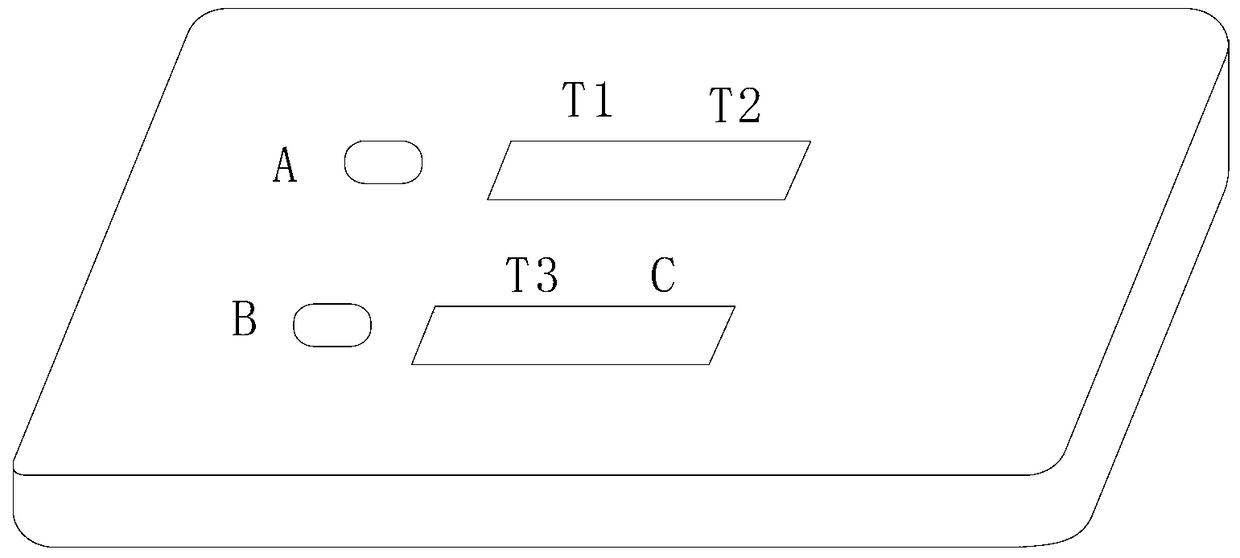Two-well immunoassay lateral flow test card
A technology of immunological lateral chromatography and test card, which is applied in the field of new double-hole immunological lateral chromatography test card, which can solve problems such as reagent failure, tailing, and instability of gold particles, and achieve the effect of improving accuracy
- Summary
- Abstract
- Description
- Claims
- Application Information
AI Technical Summary
Problems solved by technology
Method used
Image
Examples
Embodiment 1
[0036] Example 1: Labeling HLA-G monoclonal antibody A1 with red polystyrene microspheres
[0037] (1) Prepare colored polystyrene microspheres: adopt commercially available red polystyrene microspheres with a diameter of 10-150 nanometers, with active carboxyl or amino groups on them;
[0038] (2) HLA-G monoclonal antibody A1 was dialyzed overnight with pH8.0-9.0, 0.01mol / L tris-HCL buffer, and then centrifuged to remove the modified protein precipitate for later use;
[0039] (3) Suspend polystyrene colored microspheres in pH8.0-9.0, 0.01mol / L tris-HCL buffer solution, in protein cross-linking agent carbodiimide (EDC), N-hydroxysulfosuccinyl In the presence of imine, adipic dihydrazide, etc., add HLA-G monoclonal antibody A1 dropwise under constant stirring; continue stirring for 10 minutes after adding HLA-G monoclonal antibody A1, then add PEG20000 to make PEG20000 in the buffer The final concentration in the solution reaches 0.1% to stabilize the colored immune microsphe...
Embodiment 2
[0042] Embodiment 2: Preparation of novel dual-hole immunological lateral flow test card (referred to as test card)
[0043] (1) Prepare labeled antibodies A1, A2, and A3 of HLA-G, CEA, and HBsAg. Set the labeled antibodies A1 and A2 on the glass fiber membrane near well A, and set the labeled antibody A3 on the glass fiber membrane near well B. Please refer to the attached figure 1 .
[0044] (2) Prepare the capture antibodies B1, B2, and B3 for HLA-G, CEA, and HBsAg. Fix the capture antibodies B1 and B2 on the NC membrane at the T1 and T2 marks of the A hole window. Immobilize the capture antibody B3 on the NC membrane at the T3 mark in the window of well B. Goat anti-rabbit IgG is immobilized at the mark C of the window of well B.
[0045] (3) Holes A and B of the test card are the holes where the whole blood from the tip is dripped.
Embodiment 3
[0046] Embodiment 3: The principle of using a double-hole test card to detect HLA-G:
[0047] Assuming that a blood sample only contains HLA-G, HBsAg, and does not contain CEA, the chromatographic process is demonstrated as follows:
[0048] When the blood sample to be tested is dropped into hole A and hole B of the test card at the same time, in hole A, the red-labeled antibody A1 of HLA-G, which is set on the glass fiber membrane near hole A, combines with the HLA-G antigen in the sample to form HLA - G-A1 red immune complex. This red immune complex moves forward along the NC membrane. When reaching the T1 mark, the HLA-G capture antibody B1 immobilized at the T1 mark binds to HLA-G in the HLA-G-A1 red immune complex to form a red line. It indicates the presence of HLA-G in the blood sample. The HLA-G-A1 red immune complex continues to move forward. When passing the T2 mark, the HLA-G-A1 red immune complex does not react with the CEA capture antibody immobilized on the T2...
PUM
| Property | Measurement | Unit |
|---|---|---|
| diameter | aaaaa | aaaaa |
Abstract
Description
Claims
Application Information
 Login to View More
Login to View More - R&D
- Intellectual Property
- Life Sciences
- Materials
- Tech Scout
- Unparalleled Data Quality
- Higher Quality Content
- 60% Fewer Hallucinations
Browse by: Latest US Patents, China's latest patents, Technical Efficacy Thesaurus, Application Domain, Technology Topic, Popular Technical Reports.
© 2025 PatSnap. All rights reserved.Legal|Privacy policy|Modern Slavery Act Transparency Statement|Sitemap|About US| Contact US: help@patsnap.com

